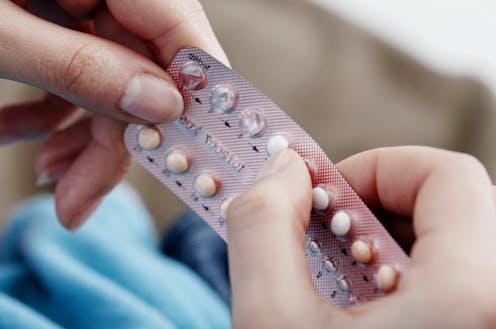
Women who are obese and taking the combined oral contraceptive pill have 12 to 24 times greater risk of developing a leg-vein blood clot than those not taking the pill and who are not overweight, according to a recent review of research. Other studies have found a lower but still increased risk.
This kind of blood clot, known as a deep venous thrombosis (DVT), can cause pain, swelling and redness of the affected leg. Usually this pain happens in the calf or thigh. Fortunately, most DVTs aren’t fatal – but they are serious and need to be treated urgently. In a small number of cases, part of the clot can break off and travel to the lungs which can be life threatening.
This increased risk might seem scary, and could even put some women off using contraception altogether if they’re overweight. But it’s important to understand where that risk comes from. And that not all types of contraception carry this increased risk.
The first thing to understand about the evidence around blood clot risk and contraception is that it only applies to contraceptive methods that contain oestrogen. These are the combined oral contraceptive pill, the contraceptive patch and the contraceptive vaginal ring.
That means that for all other methods available the evidence doesn’t show an increased risk of developing a clot in healthy women who are not obese and don’t smoke. Smoking can also increase a person’s overall risk of blood clots, both in the leg and in the blood supply to the heart and brain.
The second thing to look at is the risk for all women of developing a clot, either while using contraception or not using it.
In general, the risk of developing a clot in the leg varies with age. But in young women worldwide, who are not using hormonal contraception, around two in every 10,000 will develop a blood clot each year. This is very low.

But the risk of developing a blood clot while on the combined oral pill is between two and six times higher than for women not using the combined pill. This works out at about five to 12 women per 10,000 each year – depending on the type of combined pill. Older pills containing levonorgestrel have the lowest risk.
The risk of developing a blood clot on the combined pill is about the same as the risk of developing a clot during or immediately after pregnancy. The patch and vaginal ring, which both contain oestrogen, increase the risks by about the same amount as the combined oral pill.
The contraceptive injection seems also to increase the risk by a small amount – but this risk is still less than oestrogen-containing birth control methods.
Obesity and DVT
Being overweight increases everyone’s chance of developing a DVT, and this seems to be especially the case in women. People who are considered obese (a BMI of over 30) are at about a three to five times greater risk of having a venous clot than those who have a healthy BMI.
There are two reasons that obesity increases risk of DVT. People who are obese have more abdominal fat, which can slow the speed of blood flow travelling from the legs and through the abdomen. This increases the chance of blood clotting.
Obesity also seems to cause low-grade inflammation in the body, which may make it easier for clots to form and may also make them less likely to be dissolved naturally.
Oestrogen has a similar effect to excess weight, also making the blood more likely to form clots and less likely to dissolve small clots when they happen. This is why obesity can put women taking oestrogen-containing contraceptives at even greater risk of DVT.
To lower your risk of a blood clot in general, it’s best to maintain as healthy a weight as possible, to avoid smoking and keep an eye on your blood pressure. Since both obesity and oestrogen can increase the likelihood of a blood clot in the leg, it’s not surprising the combination of these two factors increases blood clot risk substantially.
If you are worried about your risk of a blood clot, that doesn’t mean you can’t use contraception. There are still many safe contraceptives you can choose from which do not contain oestrogen, and therefore do not increase risk of a clot. This includes condoms, the copper IUD (which contains no hormones) or the progesterone-only pill, intrauterine system or implant (which only contain progestogen).
Susan Walker has receives funding from Bayer and NaturalCycles..
This article was originally published on The Conversation. Read the original article.







